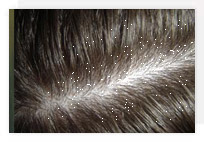Dandruff - treatment, causes and symptoms

Dandruff is a common symptom in which the sebaceous glands on the scalp increase their activity, ccelerating the SKIN’s normal, continuous process of replacing itself. Consequently the skin on the scalp sheds cells at an accelerated rate, causing visible patches of collected cells that accumulate on the scalp’s surface (most commonly on the top of the head) or flaking that may appear in the HAIR and on the clothing. BACTERIA and yeast (FUNGUS) normally present on the skin can irritate and inflame the sebaceous structures of the scalp, a condition doctors call seborrheic DERMATITIS. Dermatologists often diagnose seborrheic dermatitis as the underlying cause of dandruff. PSORIASIS and tinea capitis are also common causes.
Flaky, patchy SKIN on the eyebrows, around the eyelashes, and other sites on the body beyond the scalp may signal a dermatologic condition other than dandruff and requires a doctor’s evaluation.
Though numerous factors may contribute to dandruff, dermatologists believe a convergence of genetics, age, hormones, and environmental conditions accounts for most cases, as these are the factors that generally influence sebaceous activity. Dandruff flare-ups are common during PUBERTY, PREGNANCY, and MENOPAUSE, periods of life characterized by hormonal surges. Dandruff also becomes more common during times of physical or emotional stress, and when external environmental conditions are cold and dry such as is typical in the winter.
Symptoms of Dandruff and Diagnostic Path
Light-colored patches on the scalp that flake when scratched or flakes in the hair and on the clothing are the key symptoms of dandruff. The scalp sometimes itches. The diagnostic path includes examination of the skin over all of the body to distinguish simple dry skin, which can cause flaking, from dandruff, as well as to rule out other dermatologic conditions. The dermatologist may conduct further testing, such as skin scraping or biopsy, when there is reason to suspect a condition other than one that commonly causes dandruff.
Dandruff Treatment Options and Outlook
Mild dandruff-light, barely noticeable flaking that remains along the scalp or in the hair-often clears with daily shampooing and thorough rinsing. Moderate dandruff-obvious flakes in the hair and on the shoulders-may require shampooing with products that contain ingredients to curtail the growth of keratinocytes, the cells that make up most of the skin’s outer layer (epidermis). Such shampoos typically contain selenium sulfide, zinc pyrithione, or coal-tar extracts. Which products are more effective seems a matter of personal preference.
Severe dandruff-flakes are always present in the hair and on the clothing-may require prescription shampoos or lotions that often contain stronger concentrations of the active ingredients that over-the-counter products contain. For very severe dandruff with INFLAMMATION of the skin and sebaceous structures, the doctor may prescribe corticosteroid drops or lotion in combination with other remedies. Stubborn dandruff may require a regimen of products to bring it under control, though most people can then keep dandruff in check with a few core products.
Recent research suggests that many people who have seborrheic dermatitis, the most common cause of persistent dandruff, may have a skin environment that encourages a normally present fungus, Malassezia (also called Pityrosporum), to flourish in abundance. Malassezia subsists on sebum, an oil substance the sebaceous glands secrete. An overgrowth of Malassezia depletes the sebum supply, causing the sebaceous glands to increase sebum production. This in turn accelerates cell growth, generating dandruff. Shampoos and lotions containing an antifungal medication such as ketoconazole reduces the scalp’s Malassezia population, returning cell turnover to normal.
| Products to Control Dandruff | |
|---|---|
| coal-tar extracts | glycolic acid |
| ketoconazole and other antifungal shampoos | salicylic acid |
| tea tree oil | selenium sulfide |
| topical corticosteroids | zinc pyrithione |
Dandruff Risk Factors and Preventive Measures
Frequent or heavy use of hair products such as hairsprays and styling gels can further clog the sebaceous structures. Stress, hormones, and the environment can precipitate or exacerbate dandruff. Dandruff, or the skin conditions that establish dandruff such as seborrheic dermatitis, are more common in people who have PARKINSON’S DISEASE, though the reason for this remains unknown. People who are prone to dandruff that worsens seasonally often can minimize the severity of their symptoms by beginning therapeutic efforts before flaking becomes a problem.
See also CORTICOSTEROID MEDICATIONS; CRADLE CAP; HORMONE; KERATINOCYTE; KERATOSIS PILARIS; SEBACEOUS GLAND; STRESS AND STRESS MANAGEMENT.
Open discussion on the topic Dandruff - treatment, causes and symptoms
Similar interests
- Nuovi Casino
- Casinos Not On Gamstop
- UK Casinos Not On Gamstop
- Casinos Not On Gamstop
- UK Casinos Not On Gamstop
- Casino Non Aams Italia
- Slot Sites Not On Gamstop
- Meilleur Casino En Ligne
- Non Gamstop Casino Sites UK
- Meilleur Casino En Ligne
- Casino En Ligne France
- Best Non Gamstop Casinos
- Casinos Not On Gamstop
- UK Casino Not On Gamstop
- Casinos Not Signed Up To Gamstop
- Best Slot Sites UK
- Non Gamstop Casino Sites UK
- Online Casinos Nederland
- Online Casinos Nederland
- Casinos Not On Gamstop
- Best New Uk Casinos Not On Gamstop